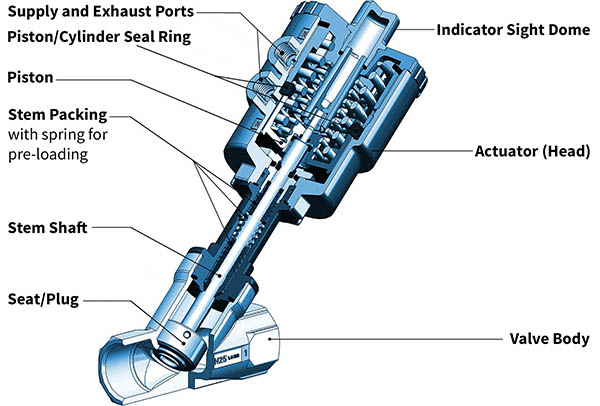Angle Seat Piston Valve on:
[Wikipedia]
[Google]
[Amazon]
{{Unreferenced, date=June 2019, bot=noref (GreenC bot)
 An angle seat piston valve is a
An angle seat piston valve is a
 An angle seat piston valve is a
An angle seat piston valve is a pneumatically
Pneumatics (from Greek 'wind, breath') is the use of gas or pressurized air in mechanical systems.
Pneumatic systems used in industry are commonly powered by compressed air or compressed inert gases. A centrally located and electrically- ...
-controlled valve
A valve is a device or natural object that regulates, directs or controls the flow of a fluid (gases, liquids, fluidized solids, or Slurry, slurries) by opening, closing, or partially obstructing various passageways. Valves are technically Pip ...
with a piston actuator
An actuator is a machine element, component of a machine that produces force, torque, or Displacement (geometry), displacement, when an electrical, Pneumatics, pneumatic or Hydraulic fluid, hydraulic input is supplied to it in a system (called an ...
providing linear actuation to lift a seal off its seat. The seat is set at an angle to provide the maximum possible flow when unseated. Angle seat piston valves are particularly suited to applications where high temperatures and large flow rates are required, such as steam or water. When used in reverse some models of angle seat piston valve will eliminate water hammer
Hydraulic shock ( colloquial: water hammer; fluid hammer) is a pressure surge or wave caused when a fluid in motion is forced to stop or change direction suddenly: a momentum change. It is usually observed in a liquid but gases can also be aff ...
when operated.
Operation
Pneumatic valves are operated by a pilot medium under pressure, usuallycompressed air
Compressed air is air kept under a pressure that is greater than atmospheric pressure. Compressed air in vehicle tires and shock absorbers are commonly used for improved traction and reduced vibration. Compressed air is an important medium for t ...
but also oil or water.
The valve is equipped with a pneumatic actuator
A pneumatic control valve actuator converts energy (typically in the form of compressed air) into mechanical motion. The motion can be rotary or linear, depending on the type of actuator.
Principle of operation
A pneumatic actuator mainly con ...
supplied by a three-way solenoid valve
A solenoid valve is an electromechanically operated valve.
Solenoid valves differ in the characteristics of the electric current they use, the strength of the magnetic field they generate, the mechanism they use to regulate the fluid, and the ...
. The pressure of the pilot medium enters the actuator cylinder and acts on the piston, which allows the seal to open or to close through the stem. The return of the seal into its rest position is usually achieved by a return spring that can be found in the pneumatic actuator.
In the double-acting configuration, there is no return spring and the pilot medium is used both for opening and for closing the valve.
A red indicator becomes visible through the sight dome that is found on the top of the actuator when the valve is in the open position.
The pressure range depends on the pressure of the pilot medium and the controlled medium and on the direction of the flow, but also on construction parameters of the valve, such as the diameter of the orifice, the diameter of the actuator cylinder and the spring force.
See also
*Piston valve
A piston valve is a device used to control the motion of a fluid or gas along a tube or pipe by means of the linear motion of a piston within a chamber or cylinder.
Examples of piston valves are:
* The valves used in many brass instruments
* ...
Valves